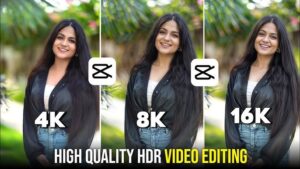In the digital age of content creation, video quality has become a primary focus for creators, marketers, filmmakers, and influencers. With the rise of 4K resolution and HDR (High Dynamic Range) technology, editing videos at this high standard is no longer a luxury — it’s a necessity for professional-grade visual content. Whether you’re editing cinematic clips, YouTube videos, or social media reels, 4K HDR video editing allows you to craft visually stunning, lifelike videos with crisp detail, vibrant colors, and optimal lighting balance.
This guide will cover everything you need to know about 4K quality HDR video editing — what it is, how it works, its features, pros and cons, and the best alternatives available in 2025. Whether you’re a beginner or an advanced editor, this comprehensive article will help you understand and start editing like a pro.
What is 4K Quality HDR Video Editing?
✅ Understanding 4K Resolution
4K refers to a resolution of 3840×2160 pixels, which is four times higher than Full HD (1080p). It provides ultra-clear visuals, sharp edges, and fine details. With more pixels, you can zoom, crop, or pan footage without losing quality.
✅ What is HDR (High Dynamic Range)?
HDR enhances the dynamic range of videos — the difference between the darkest blacks and the brightest whites. It allows for a more realistic and immersive viewing experience with:
-
Better contrast
-
More accurate color representation
-
Enhanced brightness control
✅ Combined Power: 4K + HDR
When combined, 4K HDR video editing means editing content that’s both ultra-high resolution and features expanded color/brightness details, ideal for modern screens, smart TVs, and professional streaming platforms.
How 4K Quality HDR Video Editing Works
Editing 4K HDR video requires both software support and hardware capability. Here’s a breakdown of how the process typically works:
1. Importing 4K HDR Footage
You need a camera or phone that captures in 4K HDR (like iPhones, DSLRs, or mirrorless cameras). The footage is imported into an editing software that supports both resolution and HDR metadata.
2. Hardware Requirements
-
Processor: Multi-core (i7 or M1 chip or better recommended)
-
RAM: Minimum 16GB (32GB preferred)
-
Graphics Card: Dedicated GPU (NVIDIA RTX / AMD Radeon)
-
Storage: SSDs for faster read/write speeds
3. Editing Workflow
-
Color grading for HDR output
-
Layer-based effects and transitions
-
Frame-by-frame editing in high resolution
-
Export using HDR-compatible codecs (e.g., H.265, ProRes)
4. Export and Rendering
Export settings must preserve HDR metadata and 4K resolution, which can be processed via GPU acceleration for faster render times.
Features of 4K Quality HDR Video Editing [Completely Detailing]
Here are the top features offered by modern 4K HDR video editing apps and software:
🔹 1. Real-time 4K Playback
Advanced editors provide real-time preview even in 4K resolution without lag. This ensures smoother editing without frequent buffering.
🔹 2. HDR Color Grading Panel
Adjust exposure, contrast, saturation, and highlights/shadows for HDR footage with precision. This helps in achieving cinematic tones and natural color dynamics.
🔹 3. Multi-track Timeline
Layer audio, effects, subtitles, and multiple video layers efficiently using multi-track timelines.
🔹 4. Keyframe Animation Support
Add motion graphics, transitions, and object movement using keyframes. Essential for dynamic content creation.
🔹 5. LUT Support
Apply Look-Up Tables (LUTs) to simulate film looks or color styles easily.
🔹 6. Advanced Export Options
Choose between formats like MP4, MOV, MKV with H.264 or H.265 encoding, and custom bitrate control.
🔹 7. AI-based Tools
Modern editors integrate AI for auto color correction, face tracking, smart object removal, and background blur.
🔹 8. Proxy Editing
Lower resolution versions are created temporarily to edit smoothly on less powerful machines.
🔹 9. Hardware Acceleration
Utilizes GPU to speed up rendering, exporting, and effects processing — ideal for large 4K HDR files.
🔹 10. Dolby Vision and HDR10 Compatibility
Ensure your videos are compatible with HDR display standards for YouTube, Netflix, and Apple TV.
Pros of 4K Quality HDR Video Editing [Use Table]
| Pros | Details |
|---|---|
| 🔍 Ultra-High Detail | 4K resolution ensures every frame is crisp, even when zoomed in. |
| 🌈 Realistic Colors | HDR gives deeper blacks, brighter whites, and richer colors. |
| 🖥️ Future-Proof Content | Ideal for large screens, smart TVs, and future viewing technologies. |
| 🎬 Professional Output | Necessary for filmmaking, commercials, and professional content creation. |
| 📤 Better Compression | 4K files in H.265 offer higher quality at lower sizes. |
| 🧠 AI Automation Tools | Speeds up color grading and effect suggestions with precision. |
| 📈 Increased Engagement | High-quality content retains viewer attention and boosts social engagement. |
Cons of 4K Quality HDR Video Editing [Use Table]
| Cons | Details |
|---|---|
| 💻 High Hardware Demand | Requires high-end computers or laptops for smooth operation. |
| 🗃️ Large File Sizes | 4K HDR files are significantly larger, demanding more storage and bandwidth. |
| ⏳ Longer Export Times | Due to resolution and HDR rendering, exports take longer. |
| 📱 Limited Mobile Support | Only a few mobile apps fully support 4K HDR editing. |
| 🎯 Steep Learning Curve | Requires knowledge of HDR workflows, codecs, and color science. |
| 💵 Expensive Software Licenses | Professional software like Final Cut Pro or Adobe Premiere can be costly. |
4K Quality HDR Video Editing Alternatives [Use Table]
| Software/App | Platform | Features | Free/Paid |
|---|---|---|---|
| Adobe Premiere Pro | Windows, macOS | Industry standard, HDR support, AI tools | Paid (Subscription) |
| Final Cut Pro X | macOS | Fast 4K HDR editing, Dolby Vision support | Paid (One-time) |
| DaVinci Resolve | Windows, macOS, Linux | Advanced color grading, full HDR suite, free tier available | Free/Paid (Studio) |
| CapCut (Pro) | Android, iOS, Web | Mobile HDR editing, AI auto-enhancement, LUTs | Free (Pro = Paid) |
| KineMaster | Android, iOS | Multi-track timeline, 4K export | Free/Paid |
| Lumafusion | iOS, iPadOS | 4K HDR editing on iPads, magnetic timeline | Paid |
| PowerDirector | Windows, Android | 4K HDR templates, FX, transitions | Free/Paid |
| VSDC Video Editor | Windows | Free editor with HDR support, lightweight interface | Free |
4K Quality HDR Video Editing – Tips and Best Practices
1. Use SSDs and High-Speed Cards
For smooth import and export, use SSDs and UHS-II SD cards to handle 4K HDR data speeds.
2. Match Color Profiles
Ensure that your display and editing software support HDR color spaces like Rec. 2020 or DCI-P3.
3. Calibrate Your Monitor
To edit HDR content accurately, use a color-calibrated HDR monitor.
4. Leverage Proxies if Needed
Don’t crash your system — use proxy editing when necessary and switch to full-res during export.
5. Export for Platform Compatibility
Export with the correct HDR metadata (e.g., HDR10 for YouTube, Dolby Vision for Netflix).
6. Keep Backups
Due to file size and processing load, always back up your project files in external drives or cloud.
Conclusion
4K Quality HDR video editing is no longer reserved for Hollywood — it’s accessible to YouTubers, social media creators, and mobile videographers. With the proper tools, hardware, and workflow, anyone can create breathtaking visuals that leave an impact.
While the learning curve and system requirements can be steep, the rewards are immense: stunning clarity, vibrant colors, and videos that truly stand out in today’s competitive content landscape. Whether you’re a beginner looking to enhance your social videos or a pro aiming for cinematic quality, 4K HDR editing is your gateway to excellence.




